NYC’s Forgotten ‘War on Christmas Trees’
Discover how an obscure holiday crackdown affects festive street vendors today!



As the weather gets warmer and New York begins to open up parks and other public spaces, many New Yorkers may find themselves strolling through Central Park, walking the Coney Island Boardwalk, or even walking down the middle of newly closed-off roads. Although many art museums have opened in the past few months, the city and the surrounding area is filled with public art installations and sculpture parks for both art enthusiasts and New Yorkers looking for a new place to walk around. Here is our guide to New York City’s sculpture parks.

Although not officially a sculpture park, Central Park is home to over fifty sculptures, statues, and fountains, showcasing everything from an Egyptian obelisk to equestrian statues to memorials of famous musicians. Like many parks across the city, Central Park has a number of war memorials including the bronze 107th Infantry Memorial of World War I and the USS Maine National Monument at Columbus Circle.
Found throughout the park are a number of historical monuments dedicated to figures like Christopher Columbus, American politician Daniel Webster, King Władysław II Jagiełło of Poland, and Alexander Hamilton. There are a number of sculptures dedicated to revolutionary leaders like Simón Bolívar, José de San Martín, and Giuseppe Mazzini.
The park also contains memorials of famous authors on Literary Walk like Hans Christian Andersen, Robert Burns, and Sir Walter Scott, in addition to one of Cuban revolutionary poet José Martí. Musicians like Ludwig van Beethoven and Duke Ellington (which was the first New York City monument to an African-American artist) and scientists like Alexander von Humboldt are also found throughout the park.

Bethesda Fountain and The Angel of the Waters
The park also pays tribute to fictional characters like Alice in Wonderland and Mother Goose. A number of sculptures also depict animals, like Balto the Alaskan sled dog and Group of Bears depicting a bear standing on its hind legs while two other bears stand on both its sides. A dog also appears in Indian Hunter, the first sculpture by an American sculptor to be sited in Central Park in 1869. Other famous sculptures to check out include The Angel of the Waters in Bethesda Fountain, the Egyptian obelisk Cleopatra’s Needle, and a statue of Fred Lebow, the founder of the New York City Marathon.

Rock n Roll, Photograph by Scott Lynch, Courtesy of Socrates Sculpture Park
The Socrates Sculpture Park in Astoria is situated right on the East River across from Roosevelt Island. Founded in 1986 by sculptor Mark di Suvero, the park features works from both local and internationally acclaimed artists. The vast majority of the park’s artworks were commissioned and built on-site at their outdoor studio art space, which would allow visitors to see the art-making process. The park has no permanent collection, but all past exhibitions are available on their website.
Through the end of spring, the park is home to two exhibits: The Socrates Annual, and Broadway Billboard: “To the Avengers of the New World.” The former features commissions made by artists awarded with the “Socrates Annual” fellowship. Works range from Jesus Benavente’s ‘I Still Remember You Mijo (Votive Vela),’ featuring the title phrase surrounded by a pair of wings in red, to Paul Kopkau’s ‘Yard Shadow: Nokia’ & ‘Yard Shadow: Samsung,’ steel outlines of technology.
According to the park’s website, “Ranging from fantastical to anecdotal to pedagogical, this year’s artists use a variety of narrative strategies. Several artist projects examine storytelling’s many material manifestations, from an homage to a Native American myth in which North America exists on a turtle’s back to a suggestion that a giant has fallen asleep under the Park’s blanket of grass, its exposed nose becoming refuge for a wandering monitor lizard.”
The other exhibit is a billboard made by artist Dread Scott and considers the impact and legacy of slave rebellions led by figures like Gabriel Prosser and Denmark Vesey. Each name is followed by an ampersand, and a flame at the bottom right corner “suggests both the intensity and power of these leader’s battles against oppression and memorializes their stories.”
In the summer, the park will be releasing a new exhibit titled “MONUMENTS NOW,” with new commissions for contemporary monuments by Jeffrey Gibson, Paul Ramírez Jonas, and Xaviera Simmons. The exhibition will commemorate the narratives of underrepresented communities, such as Indigenous, queer, and diasporic groups.
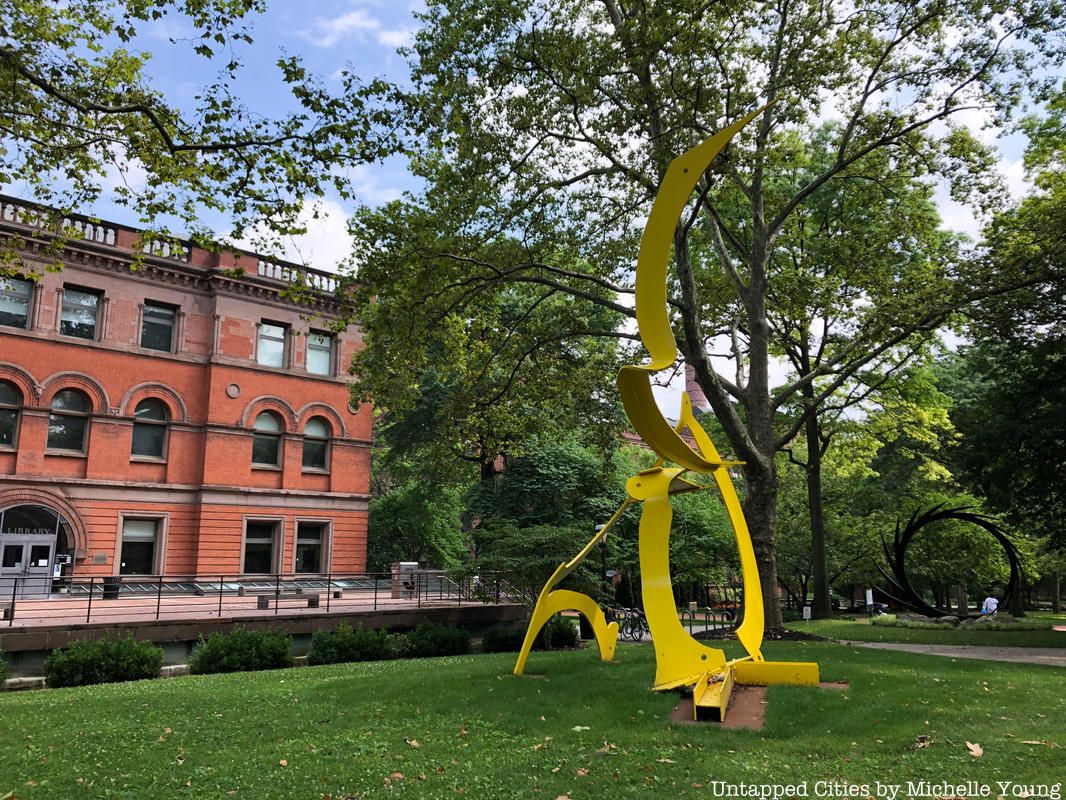
Pratt Institute Sculpture Garden
Although temporarily closed due to coronavirus, the Pratt Institute Sculpture Park in Brooklyn contains over 60 pieces of large-scale sculptural work. Famous artists like the architect of The Oculus‘Santiago Calatrava, Mark di Suvero, and Tony Rosenthal have their works featured at the sculpture park. “Deepening a sense of place, the Sculpture Park stimulates diverse audience responses, encourages questioning and curiosity, and creates lively gathering spots for campus users,” the Institute writes.
Among the works featured are Calatrava’s S7, made of painted plate aluminum in the shape of a circle, Sandy Macleod’s Uplifting, consisting of found architectural and industrial objects, and di Suvero’s Paintbrush, inspired by the cut-outs of Henri Matisse. Other noteworthy works include Grace Knowlton’s 6 Copper Spheres, Siah Armajani’s Picnic Table, David Henderson’s Skylark, and Ilan Averbuch’s The Book of Stone and Steel. A full guide to the sculpture park’s pieces can be found on their website.
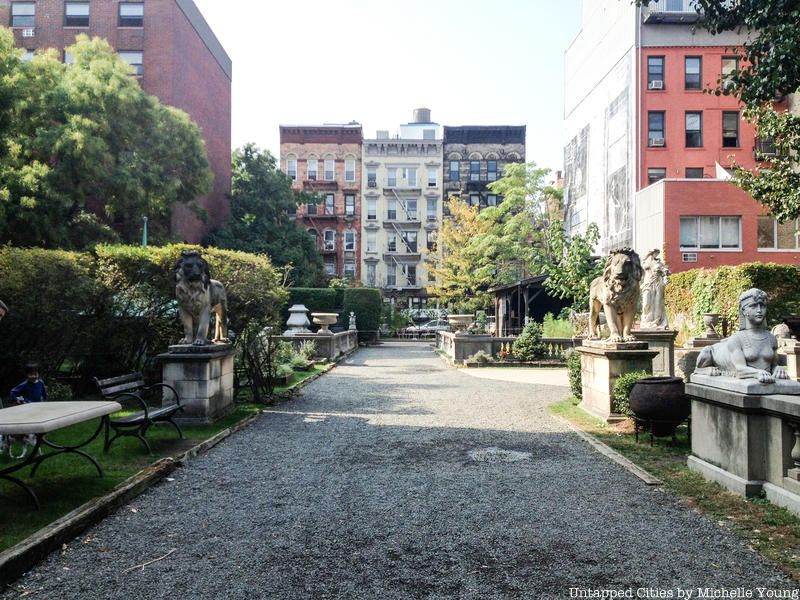
Elizabeth Street Garden
The Elizabeth Street Garden, located in between the neighborhoods of Little Italy and SoHo, is a one-acre sculpture garden with an emphasis on neoclassical sculptures. The garden often hosts neighborhood art exhibitions, yoga classes, and small festivals. However, the garden is in serious danger of being demolished in place of a new housing development, and in March 2019, the garden filed a lawsuit against the City of New York challenging the decision. According to the garden, all open spaces in Little Italy and SoHo are paved, and these two neighborhoods have a very small open space ratio of 0.07 acres per 1,000 residents. The garden has released a number of models for how the community can save the garden, as well as the garden’s vision for a sustainable future.
The sculpture garden contains a number of marble, granite, and stone statues reminiscent of neoclassical architecture. The garden houses a stone-and-granite balustrade designed by French landscape artist Jacques-Henri-Auguste Gréber. There are a number of sculptures of lions, sphinxes, and mythological figures amid flowering plants.
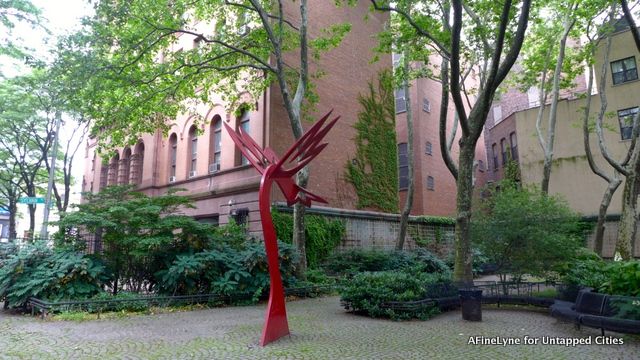
The Harlem Art Park, located in East Harlem, is a small park with a number of notable sculptures. The park was originally the proposed site of a public bath, but the space was turned into a park for a nearby senior citizen housing development. Today, the public park is nestled between the Harlem Courthouse and Casabe Houses.
The park is best known for the sculpture “Growth” by artist Jorge Rodriguez. According to Rodriguez, the former is a 15-foot-tall red sculpture that may portray a seed sprouting from the ground, an insect becoming a flower, or a bird transforming into a tree. The work is designed as an inspiration for the community to seek the kind of metaphorical growth depicted by the sculpture.
 An artwork produced from the Staten Island Makerspace
An artwork produced from the Staten Island Makerspace
Staten Island‘s Maker Park in Stapleton is an outdoor sculpture park and community work space born out of the Staten Island MakerSpace. The park opened in 2013 after transforming an empty lot of burned out cars and garbage into a green usable space. The park features many artworks that tell the story of life on the waterfront, and the park also has a number of resident bees thanks to local beekeeper Lenny Librizi.
Notable sculptures include one titled A Balloon Grows in Staten Island that depicts a cement balloon held up by steel wire, a number of graffiti works and street art on old shipping containers, and an artwork that spent a year on the water made of wooden frames and a number of colorful buoys.
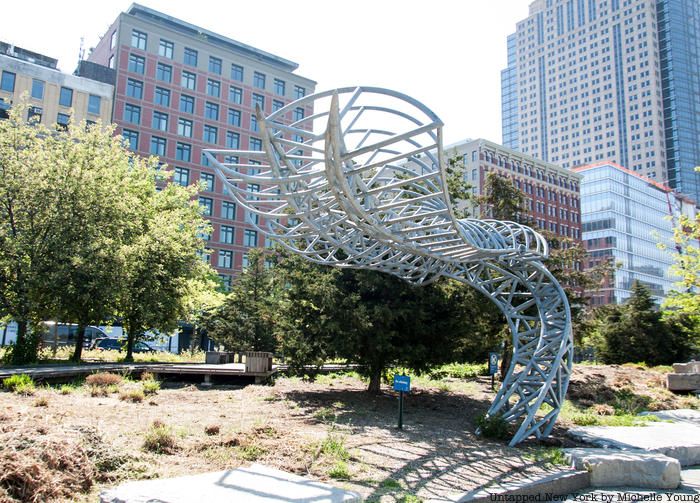
Hudson River Park is known for its amazing views of the river and neighboring New Jersey, but the park is also home to a number of sculptures between Clinton and Tribeca. While many of these sculptures are very notable, others are a bit more obscure or hidden away in the park.
Perhaps most well-known is Malcolm Cochran’s Private Passage, consisting of a 30’ x 8’6” wine bottle resting on its side. The bottle’s interior also contains a stateroom from the Queen Mary ocean liner. Further south in Hell’s Kitchen is Senes, an abstract stainless steel sculpture by William Crovello. In Chelsea, expect to find Long Time, a working water wheel that turns with the tides, as well as a stone garden named Stonefield. Greenwich Village is home to The Apple, designed by Stephan Weiss out of bronze, and the AIDS Memorial, while Tribeca houses three Serpentine Structures made of steel pipe which has been rolled, notched and welded as well as Offshoot by Mark Gibian.

Monument to The Marquis De Lafayette
Similar to Central Park, Prospect Park has its own array of sculptures and monuments depicting everything from historical figures to dragons. Perhaps one of the best known sculptures in the park is a rendition of Abraham Lincoln by Henry Kirke Brown, which prominently features two eagles. In another statue, General Henry Warner Slocum, the namesake of the PS General Slocum which sank off North Brother Island, is seen riding on horseback. Other historical sculptures include the Lafayette Memorial by Daniel Chester French and a memorial to James S. T. Stranahan, a U.S. Representative from New York.
Prospect Park is also home to a number of sculptures of composers like busts of the Norwegian Edvard Grieg, Ludwig van Beethoven, Wolfgang Amadeus Mozart, and Carl Maria Von Weber. Authors like Washington Irving and Irish poet Thomas Moore are also featured in the park. There are a number of animal-inspired works like the Dragon Fountain, the bronze sculpture Lioness and Cubs, and The Horse Tamers. The park also features a number of bas-reliefs inspired by The Jungle Book, such as Mowgli Rides the Bull Against the Tiger.
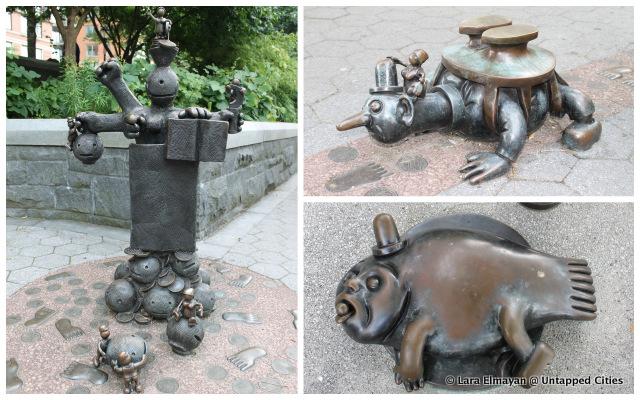
The Real World by Tom Otterness
The neighborhood of Battery Park City, featuring parks like Rockefeller Park and The Esplanade, feature a number of notable sculptures by famous artists like Tom Otterness and Louise Bourgeois. Rockefeller Park is the home of Otterness’ installation The Real World, depicting “animals and people, bankers and robbers, laborers and pilgrims, predators and prey, all rubbing shoulders in his delightfully loopy narrative world.” Like many of his works, Otterness’ The Real World features a number of sculptures bringing attention to political issues like money, evident in one in which tiny workers roll pennies towards a multi-armed tool. Also featured in Rockefeller Park is Sunrise, Sunset (Revolution) by Autum Ewalt and Dharmesh Patel, which consist of nine triptychs of varying heights that correspond to the Sun’s path from east to west horizons.

Nearby Wagner Park features Louise’ Eyes, carved in granite with pupils represented by large polished nodules. The park is also home to Tony Cragg’s Resonating Bodies, a pair of bronze sculptures resembling a giant lute and tuba respectively with a wave-like relief on its surfaces.
The Esplanade houses a number of landscape works like South Cove, which features everything from a rock garden to an arching wooden jetty to atmospheric blue lights. The Esplanade also features Martin Puryear’s Pylons, two intricately decorated stainless steel columns; one is solid, while the other is an airy spiral, and a segment of the Berlin Wall.

The Headquarters of the United Nations, in addition to holding seats of the General Assembly and the Security Council, also houses a sculpture garden with many politically inspired artworks. Perhaps the most famous sculpture is Non-Violence, a gift from the Luxembourg government that depicts a Colt Python revolver with its barrel tied in a knot. The Soviet Union gifted the sculpture Let Us Beat Swords into Plowshares, a bronze statue by Evgeniy Vuchetich that advocates converting weapons into peaceful, productive tools. The UN Garden is also home to a piece of the Berlin Wall.

A fragment of the Berlin Wall
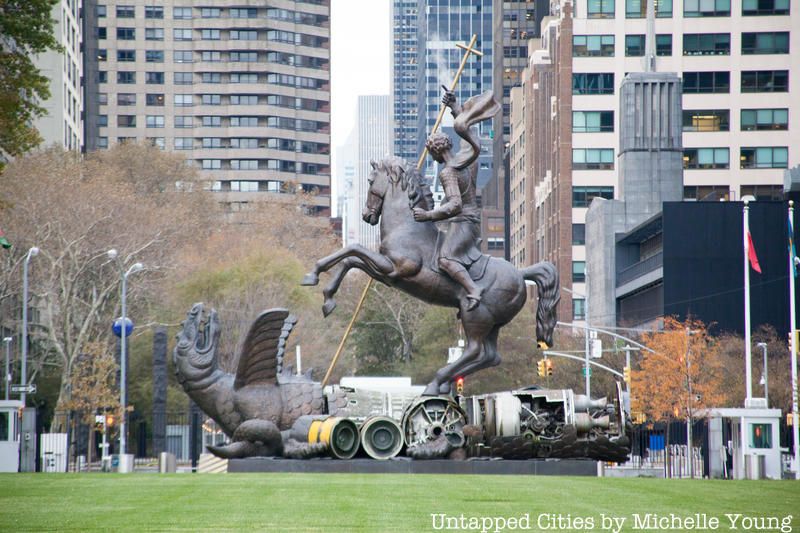
Good Defeats Evil
Other notable works include the Japanese Peace Bell, rung at the opening of each General Assembly session, and Single Form by Barbara Hepworth, a memorial to UN Secretary General Dag Hammarskjöld after his death in 1961. The UN Garden also houses a forgotten Memorial to Eleanor Roosevelt as well as a curved granite bench engraved with “1884 — Anna Eleanor Roosevelt — 1962.” Also relatively hidden is an elephant sculpture, a gift from Kenya, Namibia, and Nepal. Although the Sculpture Garden is currently closed, you can view many of these works from the street.

At the Brooklyn Museum, the Steinberg Family Sculpture Garden, although closed currently, houses over 40 sculptures predominantly made between the years 1880 and 1910 by anonymous craftsmen. Created in 1966, the garden also features a number of works by well-known artists like Louis Sullivan and Gutzon Borglum. According to their website, “Scrolls and garlands, fruit and flowers, cornucopias and shells, and geometric and foliate patterns abound, as do human and animal forms and fantastic creatures.”
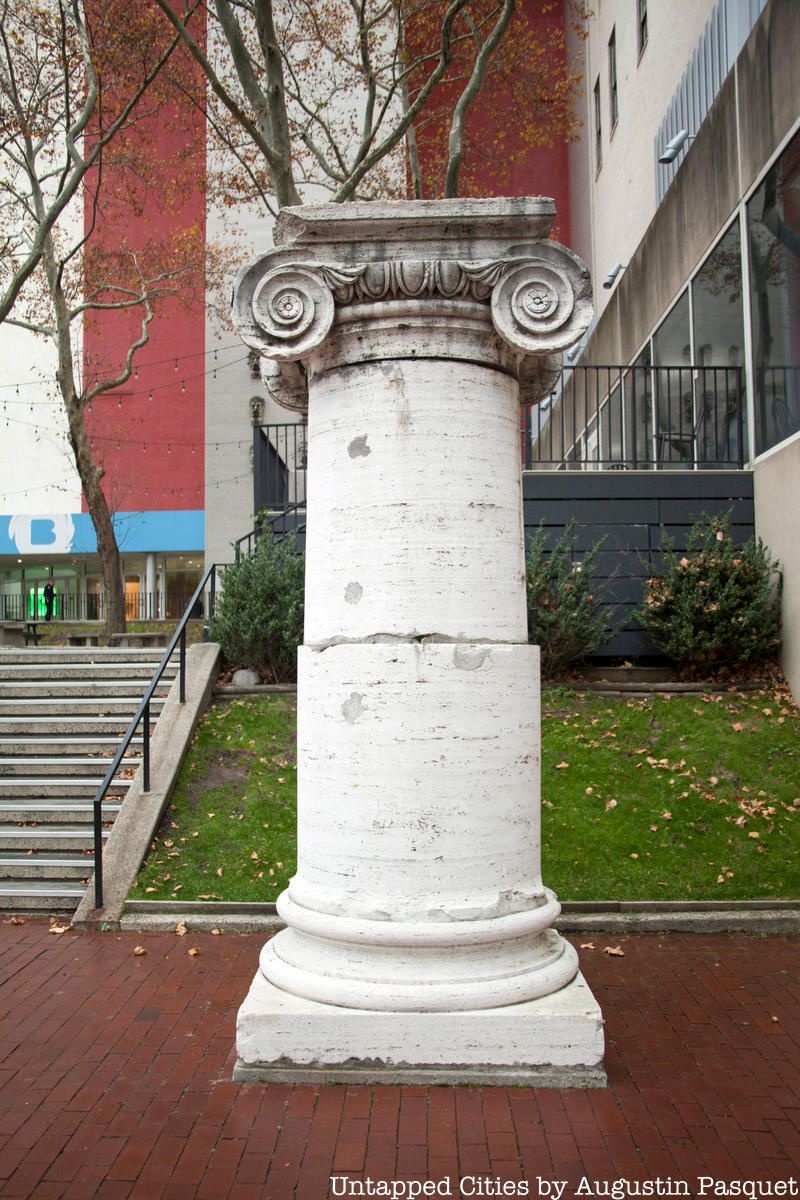
Partial Column, from Penn Station, 31st to 33rd Streets between 7th and 8th Avenues, NYC (demolished 1964)
Among the garden’s works is Night, a slumbering female figure designed by Charles Follen McKim and once stood beside a huge clock at the original Pennsylvania Station, along with a partial column from the station. Schultze and Weaver designed a series called Keystone with Head of Bearded Man that were originally at the now-demolished Park Lane Hotel. Originally at the Coney Island High Pressure Pumping Station, Irwin Chanin’s Double Pegasus depicts two winged horses in flight. Other notable works include Hugo Haase’s Lion, a park bench by J.W. Fiske Co., and Carl Milles’ Urn.
 Photo courtesy Che-Min Hsiao, an artist who previously had work at the Elmhurst Sculpture Garden
Photo courtesy Che-Min Hsiao, an artist who previously had work at the Elmhurst Sculpture Garden
The Elmhurst Sculpture Garden in Queens was opened in 2017 by Yvonne Shortt and Mayuko Fujino, offering a place for local artists to display their works while revitalizing public space. Originally, the garden was just an overgrown lot by the Long Island Expressway, but after cleaning the garden and installing sculptures, the garden opened to the public and now features Clean Up Day each Wednesday to keep the garden and surrounding area alive and safe.
The small garden currently features seven public artworks like Shotgun Home (America) by Margaret Roleke, made of numerous small toys and spent shotgun shells to comment on gun violence. Shortt’s Waking Blind depicts the face of a young girl made of clay and is about “identity and disability and draws from my cultural identity” according to Shortt. Using mylar cutouts, Fujino created Treeuphoria to depict birds and people dancing, intertwined with each other and with real plants in the garden.
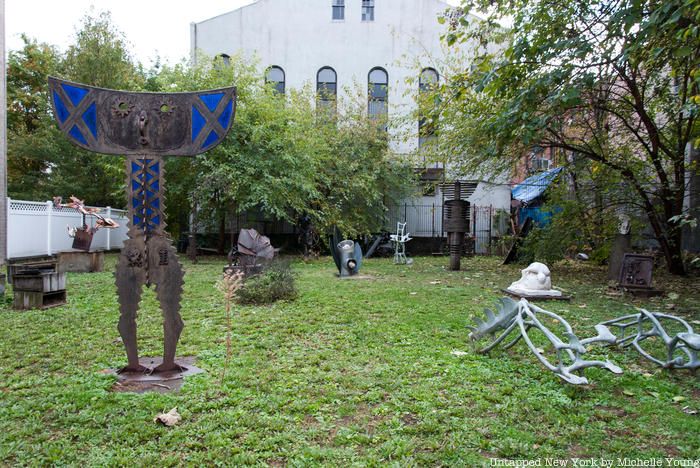
The Kenkeleba House on the Lower East Side, temporarily closed, features a small sculpture garden which can be viewed from East 3rd Street. The house is an art gallery that celebrates the cultural legacy of African American artists and artists of color who are often overlooked. The house was founded in 1974 by Joe Overstreet, Corrine Jennings and Samuel C. Floyd to support African-American culture, and today the sculpture garden features many works by minority artists.
Among the garden’s sculptures are Uzikee’s Bobo, The Flying Man, which uses steel and stained glass to depict an arm-less figure with a crescent shaped head. Artis Lane’s bronze work Amistad depicts a standing naked man to honor the slave revolt of the Mende people on the ship La Amistad. Artist Linus Coraggio has a number of works in the garden including his Bomb, which shows a torpedo-like rusted metal object suspended by a helical structure, The Battleship, and Untitled Motorcycle. Another impactful work by Jeny Polak and Wendy Klemperer is titled Don’t Let Them Kill Mumia, inspired by the works of journalist and Black Panther Mumia Abu-Jamal who was sentenced to death in 1982 despite many claiming his trial was unfair.

When walking down Avenue B by 2nd Street in Alphabet City, you may notice a garden with a rather unusual sculpture collection. This garden, entitled 2Bn2C, is the work of Ken Cro-Ken, a self defined eco-artist who aims to harness the power of nature in his art. As Cro-Ken tells us, he is “riding nature’s coattails” using paint “to show how nature works.”
Outside of 2Bn2C, Cro-Ken is a painter whose work has been honored by Hayden Planetarium, but he applies these same ideas to his sculpture gardenm which is more of a casual space for him to play around with different mediums. Cro-Ken calls it “reactive improvisation” in response to the balance of art history and nature.
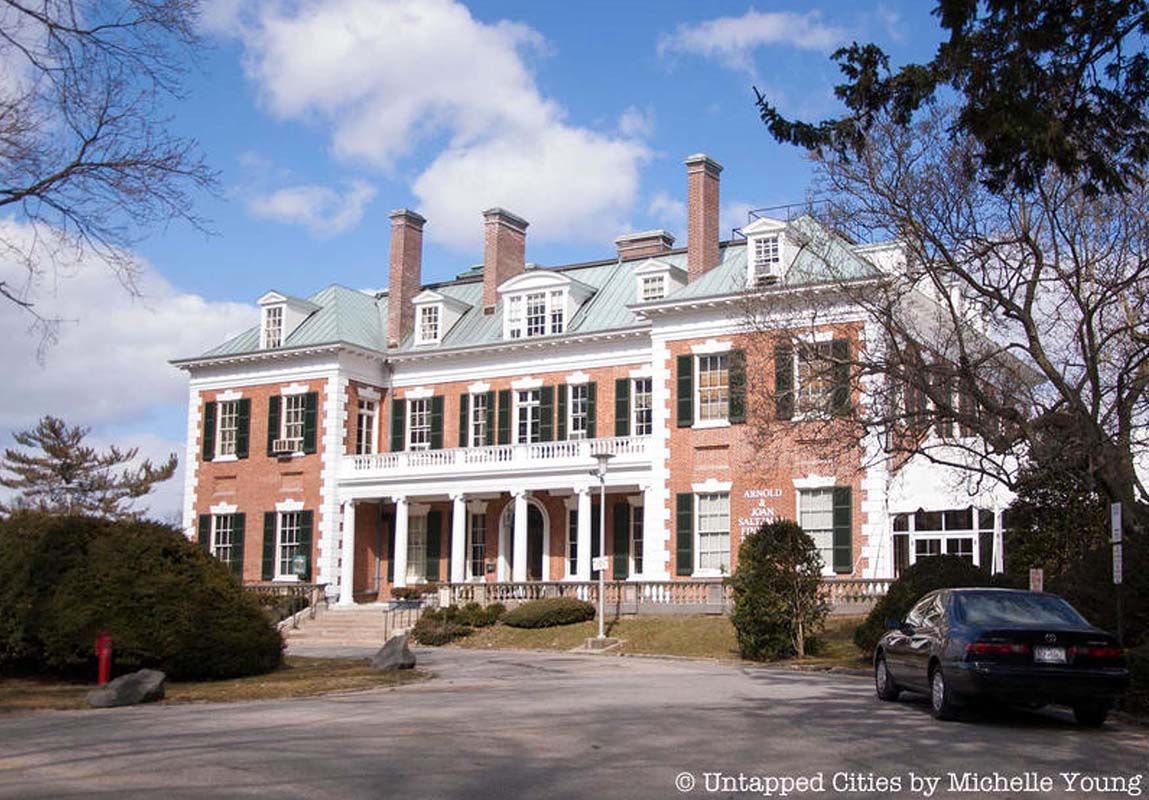
Nassau County Museum of Art
Although the actual museum is closed, the Nassau County Museum of Art, about 6 miles from the Queens-Nassau border in Roslyn, features a number of outdoor sculptures, as well as an arboretum and nature trails. Located on the former Frick “Clayton” Estate, the museum receives around 200,000 visitors a year, and many locals travel to the sculpture park daily throughout the quarantine to see works of famous sculptors like Fernando Botero and Richard Serra.
The sculpture garden includes works like Marko Remec’s NYET, made with 16 convex dome mirrors in the shape of a diamond, as well as his 26-foot tall ““Would That I Wish For (Tall Totem).” Tom Otterness, who has three sculptures on Roosevelt Island and throughout mainland Manhattan, also has his large work “Free Money” displayed at the park, as well as Mark di Suvero’s yellow sculpture One Oklock near the museum’s entrance. Also of note is Masayuki Nagare’s Nagare Bachi, Bruno Lucchesi’s Girl on a Bicycle, and Allen Bertoldi’s Redbank 31 – Nassau Variation, which consists of a number of giant square frames lined up across the grass.
Next, check out 11 monumental art pieces to discover in NYC.
Subscribe to our newsletter